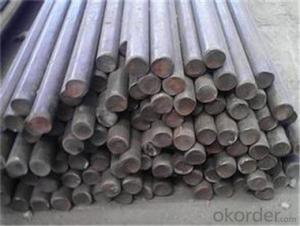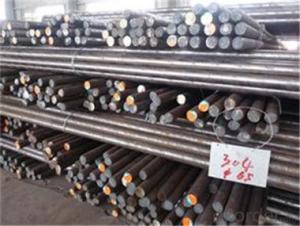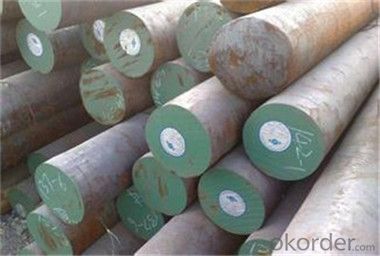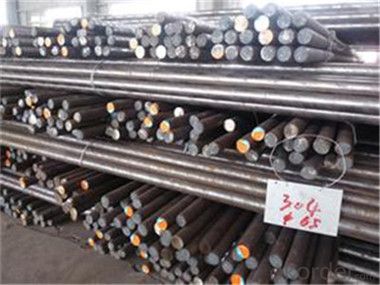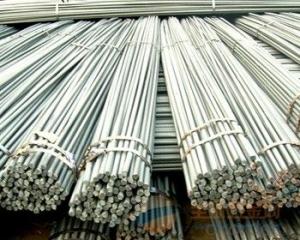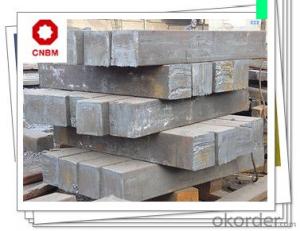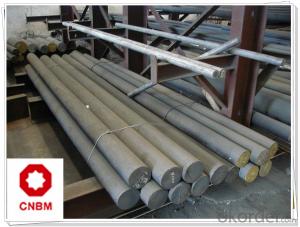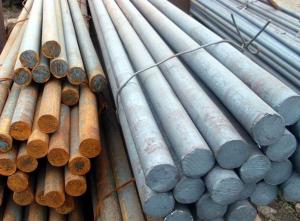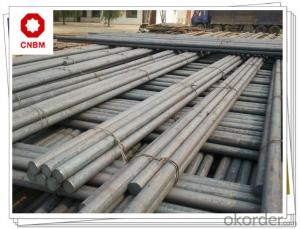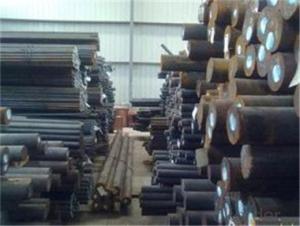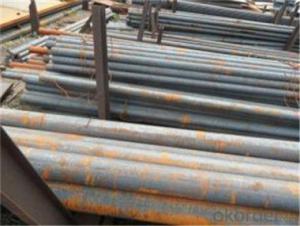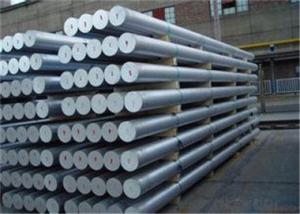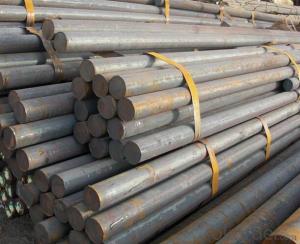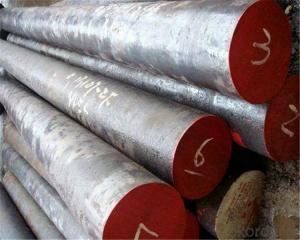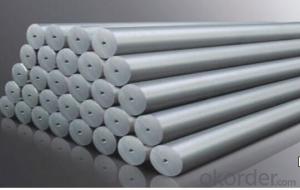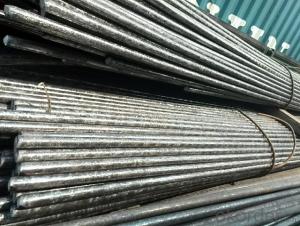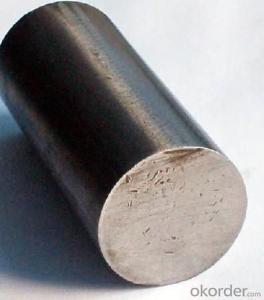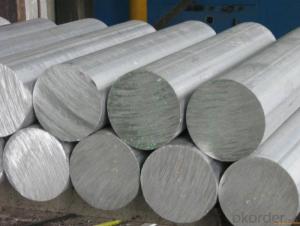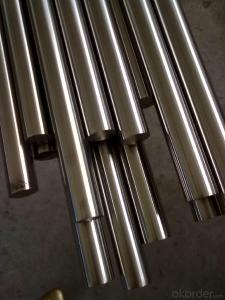42CrMO Forged or Hot Rolled Sae 4140 Steel Round Bars
- Loading Port:
- Tianjin
- Payment Terms:
- TT OR LC
- Min Order Qty:
- 332 m.t.
- Supply Capability:
- 2000000 m.t./month
OKorder Service Pledge
OKorder Financial Service
You Might Also Like
Description of steel round bar:
Mild Steel Round Bar is used for making security grills, screens, Construction and Machine Manufacture.Stainless steel bar is widely used in Architecture,Machine Manufacture,Power Station,Electric Equipment and Factory,Oil and Chemical Industry,Food and Medical Industry,City Decoration Industry
Festures of steel round bar:
Length: standard 6m,9m,12m, or as customers' requirement
Surface: Black, polished, grinded, ,Bright, Turn smooth(Peeled),Brush,Mill,Pickled
Process:Hot rolled,cold drawn,forged
Packing: In bundle, tied by steel straps, covered with protecting film
Use wooden box, fill with foam to keep the surface from damaging
Specifications of steel round bar:
Description : Steel Bar/Stainless Steel Round Bar/Alloy Steel Round Bar/Carbon Steel Bar
Stainless Steel Bright Bar/Stainless Steel Peeled Bar/Stainless Steel Polishing Bar
Diamater:
1 Hot rolled round bar diameter from 5.5mm to 110mm
2.Hot forged round bar diameter from 110mm to 400mm
3.Cold drawn round bar diameter from 2.0mm to 60mm
4.Grinding bar diameter from 4.0mm to 40mm
5.Turn smooth diameter from 40mm to 250mm
Images of steel round bar:
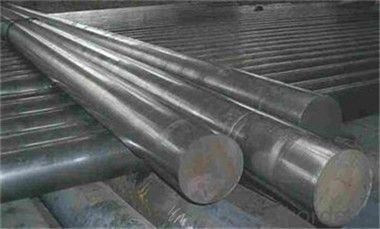
FAQ:
1. What is your main market?
We mainly export to Asia such as Japan,Korea,Thailand and North America and Middle East.
2. How long is the lead time?
Delivery time: 45 days after order confirmed.
3. What payment term do you accept?
Payment: T/T or L/C at sight.
4.Why do you choose to cooperate with us?
We have over10 years experience in this business so we are able to provide you the high quality products with the best price.
- Q: Are steel round bars suitable for use in the construction industry?
- Yes, steel round bars are commonly used in the construction industry due to their strength, durability, and versatility. They provide structural support in various applications such as reinforcement in concrete, framing, and the creation of beams and columns. Additionally, steel round bars can be easily fabricated, welded, and formed into different shapes, making them a suitable choice for a wide range of construction projects.
- Q: How are steel round bars used in the construction of pipelines?
- Due to their high strength and durability, steel round bars are commonly employed in pipeline construction. Carbon or alloy steel is typically used to produce these bars, which can be obtained in various sizes and grades tailored to meet specific pipeline requirements. A primary application of steel round bars in pipeline construction is reinforcement. They are frequently utilized to reinforce concrete foundations and supports along the pipeline route. By providing additional strength and stability, these bars ensure the pipeline remains secure and capable of withstanding external forces like soil movement or seismic activity. Furthermore, steel round bars serve as the primary material for fabricating pipeline joints. These bars are commonly bent or welded into different shapes and sizes to connect distinct sections of the pipeline. The superior tensile strength of steel ensures the joints can endure the pressure and stress exerted by the transported fluids. Additionally, steel round bars find utility in the construction of pipeline hangers and supports. These bars are often shaped and welded to create brackets or clamps that hold the pipeline in place. By furnishing a robust and dependable support system, the bars prevent sagging or movement of the pipeline, guaranteeing a smooth and uninterrupted flow. In conclusion, steel round bars play a vital role in pipeline construction. They are employed for reinforcement, fabrication of pipeline joints, and the construction of hangers and supports. Their exceptional strength, durability, and versatility make them an ideal choice for ensuring the structural integrity and dependability of pipelines.
- Q: What are the safety precautions to be taken while handling steel round bars?
- When handling steel round bars, it is important to follow safety precautions to prevent accidents or injuries. Some key safety measures to take include wearing personal protective equipment such as gloves, safety glasses, and steel-toed boots to protect against potential hazards. Additionally, ensure proper lifting techniques are used when moving or transporting the bars to prevent strain or back injuries. It is crucial to store the round bars in a designated area, away from walkways or other potential obstructions, to avoid tripping or falling hazards. Regularly inspect the bars for any damage or defects that may compromise their structural integrity. Lastly, always follow established safety protocols and guidelines provided by the manufacturer or employer to promote a safe working environment.
- Q: Are steel round bars available in different lengths?
- Indeed, there is a variety of lengths for steel round bars. These bars are designed in diverse lengths to cater to various needs and applications. The range of lengths may differ depending on the supplier or manufacturer. Typically, steel round bars are commonly available in lengths between 6 and 12 feet. However, it is also possible to acquire custom lengths through special requests. This wide range of options grants more flexibility in construction and fabrication projects, as it facilitates the ability to cut or modify the bars according to specific requirements.
- Q: What is the yield strength to tensile strength ratio of a steel round bar?
- The yield-to-tensile ratio, also known as the ratio of yield strength to tensile strength, is a significant mechanical property for evaluating the resilience of a steel round bar under tension. This ratio reflects the material's capacity to withstand deformation before failure. Generally, the yield strength represents the stress at which plastic deformation begins, while the tensile strength denotes the maximum stress the material can endure before fracturing. The yield-to-tensile ratio is determined by dividing the yield strength by the tensile strength. The yield-to-tensile ratio varies depending on the specific grade and composition of the steel. However, for most common structural steels, this ratio typically falls within the range of 0.6 to 0.8. In other words, the yield strength is generally around 60% to 80% of the ultimate tensile strength. A higher yield-to-tensile ratio indicates a more ductile and less brittle steel, as it suggests that the material can undergo substantial plastic deformation before ultimate failure. Conversely, a lower yield-to-tensile ratio implies a more brittle steel that is prone to fracture at lower levels of deformation. It is important to emphasize that the yield-to-tensile ratio is just one of several factors to consider when assessing the mechanical properties of a steel round bar. Other factors, such as hardness, toughness, and elongation, also play significant roles in determining the overall performance and suitability of the steel for a specific application.
- Q: Can steel round bars be used in the production of agricultural equipment?
- Yes, steel round bars can be used in the production of agricultural equipment. Steel is a commonly used material in the manufacturing industry due to its strength, durability, and versatility. Agricultural equipment such as plows, harrows, cultivators, and sprayers often require strong and sturdy components to withstand the harsh conditions of farming. Steel round bars can be used to create various parts of these machines, including axles, shafts, handles, and structural supports. The high tensile strength of steel ensures that the equipment can withstand the heavy loads and repetitive use that is typically required in agriculture. Additionally, steel can be easily welded, machined, and formed into different shapes and sizes, making it suitable for a wide range of agricultural equipment applications. Overall, steel round bars are a reliable and cost-effective choice for the production of agricultural equipment.
- Q: What are the advantages of using copper-alloy steel round bars?
- There are several advantages to using copper-alloy steel round bars. Firstly, the copper content in the alloy enhances the material's corrosion resistance, making it suitable for applications in harsh environments or exposed to moisture. Secondly, the combination of copper and steel results in improved strength and durability, allowing the round bars to withstand heavy loads and high-stress conditions. Additionally, copper-alloy steel round bars offer excellent thermal conductivity, making them ideal for applications where heat transfer is necessary. Lastly, copper-alloy steel round bars are relatively easy to machine and fabricate, providing versatility in various industries such as construction, manufacturing, and engineering.
- Q: How do you calculate the weight of a steel round bar based on its volume and density?
- To calculate the weight of a steel round bar based on its volume and density, you can use the formula: Weight = Volume x Density First, determine the volume of the round bar. The volume of a cylinder, which is the shape of a round bar, can be calculated using the formula: Volume = π x (diameter/2)^2 x length Where π is a mathematical constant approximately equal to 3.14159, and the diameter and length are measurements of the round bar. Once you have the volume, you need to know the density of the steel. The density of steel can vary depending on the type and grade of steel being used. The density is usually measured in kilograms per cubic meter (kg/m^3) or pounds per cubic inch (lbs/in^3). You can find the density of steel in reference materials or online. Finally, multiply the volume by the density to obtain the weight of the steel round bar. Make sure the units of volume and density are consistent. For example, if the volume is in cubic inches and the density is in pounds per cubic inch, the weight will be in pounds. If the volume is in cubic meters and the density is in kilograms per cubic meter, the weight will be in kilograms. It is important to note that this calculation assumes the round bar is made entirely of steel and has a uniform density throughout its volume. Additionally, this calculation does not consider any other factors that may affect the weight, such as impurities or surface finish.
- Q: Can steel round bars be used for tooling applications?
- Tooling applications can indeed utilize steel round bars. Steel, being a highly versatile material, possesses exceptional strength, durability, and resistance to wear and tear. By machining, heat treating, and shaping round bars made of steel, one can create a wide range of tools, including punches, dies, drills, and lathe tools. The round shape of these bars facilitates effortless machining and shaping processes. Moreover, the performance of steel round bars in specific tooling applications can be further enhanced through surface treatments or coatings. All in all, due to their outstanding mechanical properties and adaptability, steel round bars find widespread application in tooling.
- Q: What is the resistance to wear of a steel round bar?
- The resistance to wear of a steel round bar is generally high due to its hardness and durability.
Send your message to us
42CrMO Forged or Hot Rolled Sae 4140 Steel Round Bars
- Loading Port:
- Tianjin
- Payment Terms:
- TT OR LC
- Min Order Qty:
- 332 m.t.
- Supply Capability:
- 2000000 m.t./month
OKorder Service Pledge
OKorder Financial Service
Similar products
Hot products
Hot Searches
Related keywords

